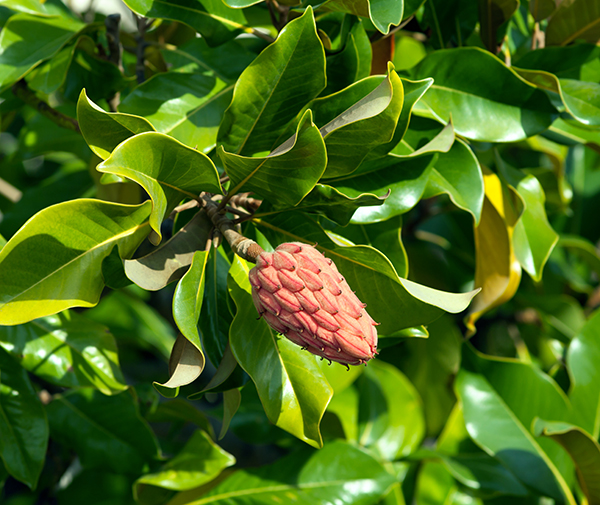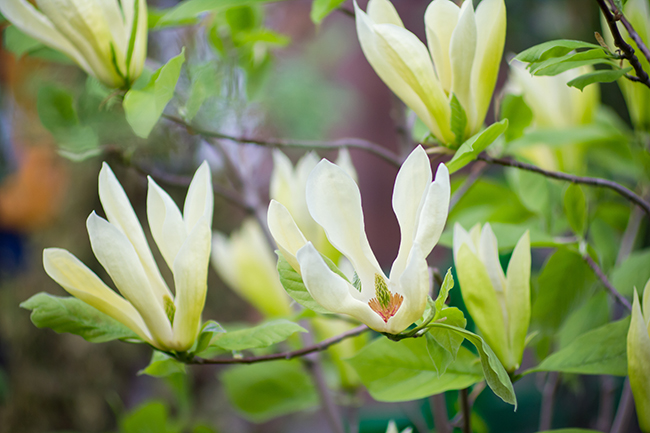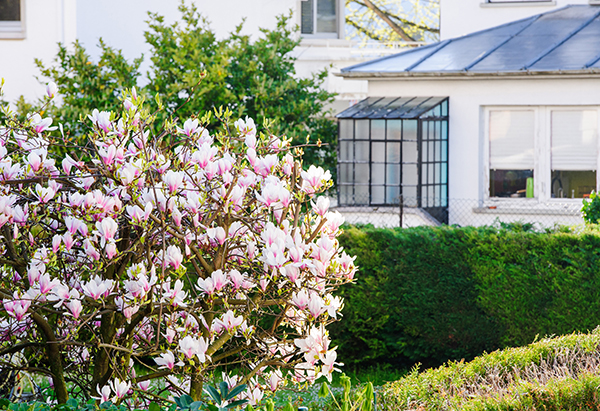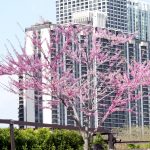
Learn more about the different types of Magnolia trees in Chicagoland and how to care for them
We have returned again this month with a new installment of our serious of the native trees of the Chicago area with a closer look at magnolia trees. Magnolia trees (Magnolia sp.) are flowering trees and plants that are believed to have appeared for the first time as far back as 95 million years ago. There are just over 200 species of magnolia plants classified within the Magnolia genus, most of which can be found throughout southeast Asia in countries including China, Japan, Thailand, and Vietnam. Various species of magnolia are also found in Central America, Mexico, and the southeastern United States.
Magnolia trees are best known for their large flowers and are often incorporated into landscapes as an ornamental plant. They are considered an ancient genus as dated fossilized specimens show that plants of this genus existed even before bees. Magnolia trees were named after French botanist Pierre Magnol by Charles Plumier, another French botanist, in 1703. Within a century of the magnolia name first appearing, botanists named many more species of magnolias throughout the world.
It was difficult for taxonomists to determine how the many different types of magnolias were related as the genus is so old that major geological events throughout history caused scattered distribution and isolated species. In the 20th century, DNA sequencing allowed scientists to map out how species of magnolias related to each other, leading to the subdivision of the genus into three subgenera: Magnolia, Yulania, and Gynopodium.
There are 210 recognized species of magnolia plants throughout the world and 8 species are native to the United States. Of the species in the U.S., there is only one species native to Illinois, the Magnolia acuminata, also known as the cucumber tree. In this guide, we will take a deep dive into the main characteristics of magnolia trees, different magnolia species in the U.S., natural threats to magnolias, and magnolia tree care tips. We will focus on the Magnolia subgenus in general which covers the magnolias native to the U.S. and the Magnolia acuminata species more specifically as the only true native magnolia in Illinois.
Magnolia trees are often planted for their spreading canopies and large, impressive flowers. If you have magnolia trees on your property, it is important that they get the proper care to grow and flower to their full potential. Hendricksen Tree Care provides professional tree services to ensure that your magnolia trees get the best possible care. Our professional arborists provide tree care and maintenance to ensure the health of your trees as well as tree trimming and treatments for diseases and insect infestations. Our tree care services will help protect your trees from disease and pests and ensure that they grow to their full potential.
Main Characteristics of Magnolia Trees
With so many species of magnolia trees, there are some shared characteristics and characteristics that differ depending on the subgenus and species. There are species of deciduous and evergreen magnolia trees and shrubs and the height of the tree largely depends on the species. What many magnolia species do have in common are large fragrant flowers and cone like fruits.

The cone-like fruit of the Magnolia tree can become a striking feature in the Fall
The following are the main characteristics of magnolia trees:
- Height: The height of a magnolia varies widely as magnolia shrubs generally get to 8 to 15 feet, small magnolia species can get as tall as 25 feet, mid-sized magnolias can grow up to 40 feet, and large magnolias have been known to get over 100 feet and about 40 to 50 feet wide. The Magnolia acuminata generally grows between 50 and 70 feet tall.
- Flowers: The flowers are one of the most defining characteristics of magnolia trees as most species have large fragrant flowers. The flowers are generally star shaped or bowl shaped and may be white, pink, green, yellow, or purple. The flowers of most species bloom in the spring through some species may bloom later in the season. The flowers of the Magnolia acuminata appear late in the spring and are small or yellow-green in color.
- Leaves: The leaves of deciduous magnolia trees are oval in shape and appear green and leathery. The leaves grow alternate and the size varies by species as smaller magnolia leaves are 4-6 inches in length while larger magnolias can have leaves as long as 10 inches. The leaves of the Magnolia acuminata tend to be 5-10 inches.
- Fruit: Most magnolia species produce a cone-like fruit that appears in the fall. These fruits look like green cones at first and they generally turn dark red as they ripen. They are often 4-6 inches long by the time they ripen.
- Bark: Magnolia tree bark tends to be gray in color. Most species start out with smoother bark that then becomes ridged as it ages.
Species of Magnolia Trees

The Magnolia acuminata is the only truly native species of Magnolia Tree in Illinois
As discussed above, there are over 200 total species of magnolias, around 8 of which are native to the U.S. The following are the most common magnolia tree species found in the U.S. Several of these magnolias can be planted in Illinois.:
- Cucumber tree: The cucumber tree (Magnolia acuminata) is a large deciduous magnolia and one of the most cold resistant magnolia species. It can be found as far south as Louisiana and Mississippi and as far north as southern Ontario, and it is the only true native magnolia species of Illinois. These trees can grow between 50 and 70 feet on average and have been known to grow over 90 feet. They are named for their fruits which resemble cucumbers when they first appear and unlike other magnolias, the flowers of the Magnolia acuminata are not showy as they are small and yellow-green in color.
- Sweetbay magnolia: The sweetbay magnolia (Magnolia virginiana) is a large magnolia tree found along the Gulf and eastern coasts of the U.S. These trees can be deciduous or evergreen as evergreens are found in areas of mild winters in the Gulf and southeastern states and they become more deciduous in northern areas such as New Jersey and Long Island. Sweetbays are known for their cream-colored flowers that are between 3 and 5 inches in diameter. These flowers also have a strong vanilla fragrance.
- Southern magnolia: The southern magnolia (Magnolia grandiflora) is a large evergreen magnolia tree found in the southeastern U.S. from eastern Texas and Louisiana to North Carolina. These trees can grow up to 120 feet tall and have a pyramidal shape with stiff broad leaves that can be up to 8 inches long. The southern magnolia has large while flowers that can measure almost 12 inches in diameter. These flowers bloom in late spring and have a lemon citronella scent.
- Fraser magnolia: The Fraser magnolia (Magnolia fraseri) is a small, deciduous magnolia tree found in the southern Appalachian Mountains. These trees can grow up to 40 feet tall with large leaves that can be 6 to 10 inches long. Their flowers can also get up to 6 to 10 inches in diameter and they have distinct pedals that are long and slender. The flowers appear in late spring or early summer after the foliage has appeared.
- Bigleaf magnolia: The bigleaf magnolia (Magnolia macrophylla) is a deciduous magnolia tree found in the southeastern U.S. and eastern Mexico. These trees can grow between 50 and 65 feet tall and they have large leaves that can be between 20 and 35 inches long. They also have large white flowers and fruits that can be up to 4 inches long.
Natural Threats to Magnolia Trees

An arborist can help you keep your Magnolia trees healthy year-round
Magnolia trees have a relatively long lifespan of 80 to 120 years if they receive good care. Like all other tree species, magnolia trees are vulnerable to diseases and pests that can cause damage or even death to the tree. It is important to look for signs of the diseases and insects that can affect your magnolia trees:
Diseases
- Algal leaf spot: Algal leaf spot is a disease caused by parasitic algae. This disease causes reddish-brown areas with velvety hair-like structures to appear on the leaves. Fortunately, algal leaf spot is more of a cosmetic issue but can stunt the growth of leaves and branches. This disease is not treated in many cases but can be treated with a fungicide.
- Fungal leaf spot: Fungal leaf spot is caused by a fungus that forms brown spots on affected leaves. Eventually these spots will grow and cause the leaves to die off of the plant. This disease can also be treated with a fungicide.
- Canker: Cankers are dead areas of bark and branches that are formed when a fungus gets inside the tree and grows between the bark and the wood. Canker infections can girdle branches of the tree and cause branches to die. The best way to treat cankers is to prune off affected branches as soon as possible. Professional arborists can provide effective tree trimming.
- Wood rot: Wood rot occurs when various fungi within the tree break down the wood and cause it to decay from the inside out. This can lead to severe damage to the trunk and branches which can cause the tree to fall apart. The only way to treat trees affected by wood rot is to remove the affected areas right away. If your magnolia trees may be affected by wood rot, consult with a professional arborist immediately to take the next steps.
Insects
- Magnolia scale: Magnolia scale are small, round insects that only grow to be about half an inch in diameter. They are tan or brown in color and they feed on the sap of magnolia trees including Magnolia acuminata. As the scale consume tree sap, they excrete a sticky material called honeydew that can cause black sooty mold to develop on leaves and branches. Large infestations can kill branches and eventually kill the tree.
- Aphids: Aphids are small insects that can appear green, yellow, or reddish brown in color and they feed on fluids from the leaves and stems. If enough of these insects infest a magnolia tree, they can cause leaves to die and fall off the tree. Heavy infestations can lead to significant defoliation.
- Magnolia root borer: Magnolia root borers can cause serious damage and even death to affected magnolia trees. These insects are black in color with long, slender bodies and they lay eggs on the bark of magnolia trees. The larvae hatch and bore into the wood of the trees to feed on the plant tissues and fluids and work their way towards the roots. This affects the overall health of the tree as damaged areas appear sunken and the leaves will begin to yellow and fall off. The tree will likely die if the infestation is not taken care of.
- Greenhouse thrips: Greenhouse thrips are small black winged insects that feed on the leaves, buds, and blossoms of magnolia trees. The leaves will likely have spots that look silver or bleached and the leaves will eventually dry out and fall from the tree. They can also stop the flowers from blooming.
- Black twig borers: Black twig borers are beetles that are brown or black in color with cylindrical bodies. The adult females bore into the twigs and branches of magnolia trees and create tunnels where they feed on plant tissue and lay eggs. The affected twigs and branches will fall off the tree if they sustain enough damage. While this damage may look severe, it is mostly cosmetic as the long-term health of the tree is rarely affected.
Magnolia Tree Care Tips
Magnolia trees are a great addition to your landscape as an ornamental tree and with the proper care, they will bloom every season for nearly a century. The following magnolia tree care tips will help you plant and maintain healthy magnolia trees:
- Planting: Magnolia trees should be planted in well-drained, sightly acidic soil in an area where they will be protected from strong winds. Evergreen magnolias prefer areas with full sun and deciduous magnolias should be planted somewhere with partial shade. The best time to plant new magnolias is in the spring.
- Watering: Newly planted magnolia trees should be watered regularly until they become established. Make sure the soil around new trees is kept moist. Once they become established, they should only be watered during periods of drought as these trees have moderate drought tolerance.
- Mulching: Laying mulch around your magnolia trees annually is beneficial. Lay a 3–4-inch layer of well composted mulch out to the drip line.
- Fertilization: Magnolia trees do not need to be fertilized as long as the tree is growing and the flowers are blooming. If the leaves of the magnolia tree are yellowing or the flowers are not blooming, you can apply a slow-release fertilizer. You should wait until the spring after planting to fertilize new magnolia trees.
- Pruning: Pruning magnolia trees is only necessary to remove damaged or diseased branches and to improve its appearance. You should prune your magnolia trees after they are done blooming in the late spring or early summer. If you prune too late in the season, the tree may produce less flowers the following spring.
Professional Tree Care for Magnolia Trees

A Magnolia tree can make a beautiful addition to Chicago homes and commercial landscaping in every season
Planting a magnolia tree in your yard or landscape will bring shade, natural beauty from the showy flowers, and pleasant fragrances. The blooming flowers of magnolia trees are a stunning sight in the spring and the dark red fruits are impressive in the fall. It is important to make sure you take proper care of your magnolia trees and to constantly check for signs of diseases or pests. You can help ensure the health of your magnolia trees by working with a professional arborist like Hendricksen Tree Care.
Our professionals at Hendricksen Tree Care provide complete tree care services that include general care and maintenance, pruning, and treatments for insects and diseases. Our ongoing treatment services will help keep your trees healthy so they grow to their full potential. We provide tree care services in Arlington Heights, Glenview, Winnetka, Mount Prospect, Northbrook, Libertyville, Park Ridge, Lake Forest, and the surrounding north and northwest Chicago suburbs.












